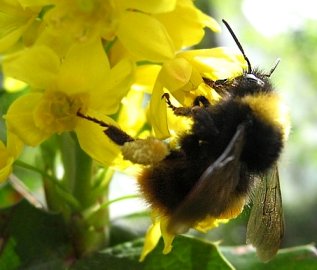
There are several means by which flowers attract bees, such as shape, scent, color, and even ultraviolet-reflective patterns. Over the past few years, researchers have found an additional one: electricity. Back in 2013, researchers determined that while bumblebees develop a positive charge, flowers tend to develop a negative charge. In addition, different species of flowers produce different patterns of negative charges. Using some pretty clever experimental techniques, the researchers showed that bumblebees use those patterns of negative charges to help them identify the best sources of nectar and pollen.1
Most of those same researchers now report that they have identified how the bumblebees detect the electrical charges displayed by flowers. They use the hairs (called filiform hairs) that cover their bodies. While these hairs detect motion and sound, the authors showed that they also respond to electric fields. The way they respond allows the bees to “read” the electric field on a flower.2
What good does that do? Well, remember that the bees are positively charged. When a bee lands on a flower, then, some of the negative charges on the flower are neutralized by the positive charges on the bees. This changes the pattern of the flower’s electric field. When that bee leaves, the pattern remains changed until the flower can replenish the negative charges that were neutralized. If another bee approaches that same flower, the altered pattern of electrical charges will tell it that a bee has already visited the flower, and therefore the flower isn’t a great source of nectar and pollen!
So this really is a form of communication between the bees and the flowers. A flower “advertises” that it has what the bees want. Once a bee visits the flower, however, its advertisement changes to say “come back later, when I have had a chance to remake what you need.”
God has designed an intimate, detailed relationship between flowering plants and their pollinators. The design is so complex that the more we study it, the more it surprises us!
REFERENCES
1. Dominic Clarke, Heather Whitney, Gregory Sutton, and Daniel Robert, “Detection and Learning of Floral Electric Fields by Bumblebees,” Science 340:66-69, 2013
Return to Text
2. Gregory P. Sutton, Dominic Clarke, Erica L. Morley, and Daniel Robert, “Mechanosensory hairs in bumblebees (Bombus terrestris) detect weak electric fields,” Proceedings of the National Academy of Sciences of the United States of America 2016, doi:10.1073/pnas.1601624113

WOW! Thank you for posting this. I wonder if Eric Laithwaite’s claims concerning moths will ever be verified (He was ridiculed for suggesting they might possess a more complicated communication mechanism) –
From WIKI –
Although Laithwaite is best known for his ideas concerning gyroscopes, he also held an idea concerning moths. It was that they communicate via ultra short wave electromagnetic phenomena (Inventor in the Garden of Eden, E R Laithwaite 1994 page 199). He persisted in this belief even after the pheromone which they actually use had been isolated[3] and could even be bought “over-the-counter” — seemingly contradicting his account. However, he had argued in 1960[4] that there must be two different mechanisms for detecting pheromones: (i) The orthodox account of chemical-gradients (effective only at short-range), and (ii) some method for long-distance detection (> “100 yards”) even when the wind was in an unfavourable direction — and the only credible solution then had to be electromagnetic (probably infrared).
Wow, jaw dropping amazing! How Great God Is!